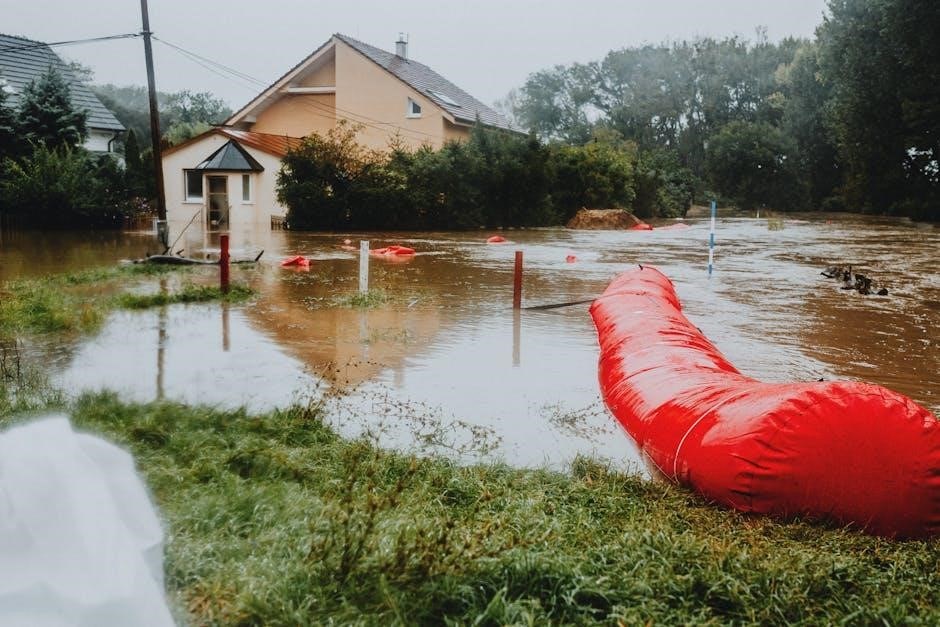iowa stormwater management manual
The Iowa Stormwater Management Manual provides comprehensive guidance for managing stormwater effectively, ensuring water quality protection, and promoting sustainable development practices statewide.
Overview of the Manual’s Purpose and Scope

The Iowa Stormwater Management Manual serves as a comprehensive guide for effective stormwater management, addressing water quality protection, flood mitigation, and sustainable urban planning. Its primary purpose is to provide standardized practices, regulations, and design criteria for stormwater systems across Iowa. The manual is tailored for local governments, developers, engineers, and planners, offering detailed strategies to manage stormwater runoff in both urban and rural areas. It covers topics such as hydrological design, best management practices (BMPs), and regulatory compliance. The manual emphasizes environmentally friendly solutions to balance development with ecological preservation. By adhering to its guidelines, stakeholders can ensure compliance with state and federal regulations while safeguarding Iowa’s water resources for future generations.
Key Objectives and Benefits of Stormwater Management in Iowa
The primary objectives of stormwater management in Iowa include protecting water quality, reducing pollution, mitigating urban flooding, and promoting sustainable land use. Effective stormwater management helps safeguard public health by reducing contaminants in waterways. It also preserves ecosystems by maintaining natural hydrological processes and biodiversity. Additionally, it supports economic growth by preventing property damage and ensuring infrastructure resilience. Communities benefit from improved water resources, enhanced recreational opportunities, and a reduced burden on drainage systems. Proper management strategies foster environmental stewardship and long-term sustainability, ensuring Iowa’s water resources remain healthy and productive for future generations. These practices align with state and federal regulations, promoting a balance between development and ecological preservation.

Regulatory Framework for Stormwater Management in Iowa
The regulatory framework for stormwater management in Iowa is established by federal and state laws, including the Clean Water Act and NPDES permits, ensuring compliance and environmental protection.
Federal and State Regulations Governing Stormwater
Federal and state regulations play a crucial role in shaping stormwater management practices in Iowa. The Clean Water Act, particularly the National Pollutant Discharge Elimination System (NPDES) program, sets the foundation for regulating stormwater discharges. The Iowa Department of Natural Resources (DNR) enforces these federal guidelines at the state level, ensuring compliance with water quality standards. Municipalities and industries must obtain permits for stormwater systems, adhering to specific requirements to prevent pollution. The integration of federal and state laws with local ordinances creates a comprehensive regulatory framework. This ensures that stormwater management aligns with broader environmental goals, addressing both point and non-point source pollution effectively.
Local Ordinances and Permitting Requirements
Local ordinances in Iowa provide tailored stormwater management requirements, ensuring compliance with federal and state regulations while addressing unique regional conditions. Municipalities often adopt ordinances that dictate permitting processes for construction, development, and stormwater system installations. These requirements may include erosion control measures, runoff management practices, and infrastructure design standards. Local governments also enforce permitting for Municipal Separate Storm Sewer Systems (MS4s), ensuring adherence to water quality goals. Additionally, ordinances may incorporate public education campaigns and inspection programs to promote compliance. By aligning local rules with state and federal frameworks, Iowa communities effectively manage stormwater while protecting water resources and public health.

Stormwater Pollution Prevention and Best Management Practices (BMPs)
Stormwater Pollution Prevention and BMPs are essential strategies to mitigate runoff impacts, safeguard water quality, and ensure sustainable environmental practices across Iowa.

Common Sources of Stormwater Pollution
Stormwater pollution in Iowa primarily stems from agricultural runoff, urban areas, industrial activities, and construction sites. Fertilizers, pesticides, and manure from farms contribute nutrients and chemicals, leading to water quality degradation. Urban runoff carries oil, grease, and sediments from roads, while industrial sites may release toxic substances. Construction activities often result in sedimentation and erosion. These pollutants contaminate waterways, harm aquatic life, and negatively impact ecosystems. Understanding these sources is crucial for implementing effective BMPs to mitigate their environmental impact and protect Iowa’s water resources.
Effective BMPs for Reducing Stormwater Runoff
Effective Best Management Practices (BMPs) for reducing stormwater runoff in Iowa include green infrastructure, permeable pavements, rain gardens, and bioswales. These strategies promote infiltration, reducing surface runoff and filtering pollutants. Agricultural BMPs, such as cover crops and buffer strips, minimize soil erosion and nutrient runoff. Urban BMPs, like detention ponds and stormwater ponds, capture and treat runoff effectively. Regular maintenance of BMPs ensures their functionality and longevity. These practices not only protect water quality but also enhance biodiversity and support sustainable land use. Implementing these BMPs is essential for mitigating stormwater impacts and promoting environmental stewardship across Iowa’s diverse landscapes.
Design and Implementation of Stormwater Management Systems
Designing stormwater systems involves hydrological assessments, engineering expertise, and collaboration with stakeholders to ensure effective, sustainable solutions for Iowa’s diverse environmental conditions and regulatory requirements.
Hydrological and Engineering Design Considerations
Designing stormwater management systems in Iowa requires careful hydrological and engineering analysis to ensure efficiency and compliance with regulations. Hydrological studies assess watershed characteristics, rainfall patterns, and runoff rates to determine appropriate system capacity. Engineering considerations include selecting suitable materials, sizing infrastructure, and integrating best management practices (BMPs) like detention ponds or green infrastructure. Site-specific factors such as soil type, topography, and land use must be evaluated to optimize system performance. Additionally, engineers must account for climate variability and extreme weather events to enhance resilience. Collaboration between hydrologists, engineers, and local stakeholders is essential to balance environmental, economic, and regulatory demands effectively.
Case Studies of Successful Stormwater Management Projects
Several case studies in Iowa highlight effective stormwater management strategies. In urban areas, green infrastructure projects like permeable pavements and rain gardens have significantly reduced runoff and improved water quality. For instance, Des Moines implemented a comprehensive stormwater plan that integrated detention ponds and bioswales, reducing flooding by 40% and enhancing biodiversity. In Cedar Rapids, a watershed-scale approach combined wetland restoration with upstream BMPs, lowering peak flows during heavy rainfall. These projects demonstrate how collaborative efforts between municipalities, engineers, and communities can achieve sustainable stormwater solutions while meeting regulatory standards and benefiting local ecosystems. Such successes serve as models for future initiatives across the state.
Monitoring, Maintenance, and Enforcement
Regular monitoring ensures compliance with stormwater regulations, while maintenance of BMPs and infrastructure prevents pollution. Enforcement mechanisms guarantee adherence to environmental standards, protecting water quality and public safety.
Importance of Regular Monitoring and Maintenance
Regular monitoring and maintenance are critical for ensuring the effectiveness of stormwater management systems. By consistently evaluating system performance, issues can be identified and addressed promptly, preventing potential failures. Maintenance activities, such as cleaning storm drains and inspecting BMPs, help maintain water quality and reduce pollution risks. Monitoring also provides valuable data to assess the long-term impact of stormwater practices, guiding improvements and ensuring compliance with regulations. Proactive maintenance saves costs by avoiding costly repairs and enhances public safety by mitigating flood risks. Overall, these practices are essential for achieving sustainable stormwater management in Iowa.
Enforcement Mechanisms for Compliance
Enforcement mechanisms play a crucial role in ensuring adherence to stormwater management regulations in Iowa. These mechanisms include regular inspections, permit reviews, and penalties for non-compliance. Regulatory agencies use these tools to monitor and enforce stormwater management practices, ensuring that both public and private entities meet established standards. Penalties for violations, such as fines or legal actions, incentivize compliance. Additionally, public reporting requirements and transparency measures help hold stakeholders accountable. These enforcement strategies are designed to protect water quality, reduce pollution, and maintain the integrity of stormwater management systems across Iowa. Compliance ensures the long-term sustainability of water resources and the health of local communities.
The Iowa Stormwater Management Manual serves as a vital resource for effective stormwater management, offering practical solutions to protect water quality and promote sustainable practices. By addressing both current challenges and future needs, the manual supports communities in adapting to environmental changes. Future efforts will focus on enhancing compliance, advancing technological innovations, and fostering collaboration among stakeholders. Continuous improvement in monitoring, enforcement, and education will ensure the state’s water resources remain protected. As Iowa evolves, the manual will remain a cornerstone for achieving long-term environmental sustainability and resilience. Its principles and guidelines will continue to guide efforts in safeguarding Iowa’s waterways for future generations.